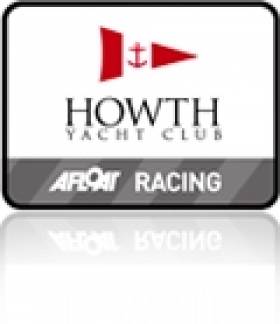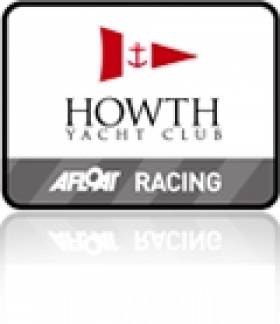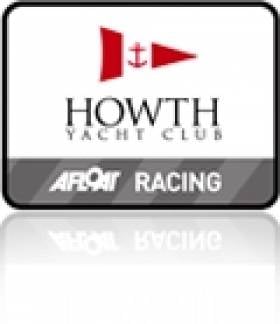Displaying items by tag: Howth YC
Electro to Sponsor Howth Yacht Club Lambay Races
The annual Howth Yacht Club Lambay Race - Howth Regatta - is to be called the Electro Lambay Race following confirmation of sponsorship by Electro Automation Group, widely regarded as Ireland's premier automation specialist and an international leader in such areas as automated car park systems, gate and door access control systems, and intelligent transportation systems.
The race takes place on June 12 and online entry is available now. (see below)
Operating from headquarters in Damastown, near Mulhuddart, Electro was established in 1984 and now has operations in Lisburn, Galway, the UK, and Germany. The Electro brand is synonymous with advanced technology and service reliability across a wide range of products that control movements of personnel and vehicles, automatic gates and bollards, doors and barriers, hands-free access control, under-vehicle surveillance and CCTV security.
The Electro sponsorship will include a significant input into the 'family day' theme of this year's sailing which is expected to attract around 140 boats and over 1,000 sailors and visitors.
Pinocchio Out in Front in Howth Yacht Club
Noel Davidson's Puppeteer Pinocchio emerged as winner of Tuesday night's Howth Yacht Club race with Cloud 9 (C Feeley) second and Enigma, D. Butler third.
HOWTH YACHT CLUB TUE + SAT SERIES 1 (RACE) 11/05/2010 17 Footer SCRATCH: 1, Rita Lynch/Curley; 2, Deilginis Cruise/Others; 3, Leila R Cooper; 17 Footer HCAP: 1, Anita Cassidy/Young; 2, Echo B & H Lynch; 3, Deilginis Cruise/OthersTUESDAY SERIES 1 (RACE) 11/05/2010 Puppeteer SCRATCH: 1, Pinocchio Swan/Davidson; 2, Harlequin Clarke/Egan; 3, Ibis G May; Puppeteer HPH: 1, Pinocchio Swan/Davidson; 2, Cloud 9 C Feeley; 3, Enigma D Butler; Squib SCRATCH: 1, Kerfuffle J & H Craig; 2, Chatterbox J Kay; 3, Pegasus K T & K Smyth; Squib HPH: 1, Kerfuffle J & H Craig; 2, Chatterbox J Kay; 3, Pegasus K T & K Smyth; Etchells SCRATCH: 1, Glance Dix/O'Reilly; 2, Kootamundra Wattle O'Grady/Reilly; 3, Lambay Rules L Dillon; SB3 SCRATCH: 1, Lia D Barry; 2, Investwise D Quinn; 3, Sin a Bhuifl Guinness/Costigan
Fowler wins Investwise HYC Open
Andrew Fowler took his first win in a truncated weekend of match racing, dominating a light and tricky Sunday of racing in Howth Yacht Club for the Investwise.ie Dublin Match Race Open. With Saturday's sailing canned due to high winds and heavy seas, the event was shortened to just a single day of racing and a single round robin for the nine teams ahead of the final.
Sunday brought blue skies and never more than 13 knots, and the crews spent almost ten hours on the water in the ISA Sailfleet J80s to get one full round robin in, with each boat sailing eight races. With reigning champion John Sheehy away racing the Wilson Trophy in England, the pressure was on Andrew Fowler and his team as top-ranked Irish entry, with UK helm Mark Lees and his crew of Roddy Lacey, Toby Mumford and Matt Reid another team to watch.
Fowler and Team Lazarus (Brendan Faffiani, Guy O'Leary and Dave McHugh on main) duly delivered, sailing an immaculate round robin to finish the series without dropping a single race. The Howth MadMatch team, skippered by Ben Duncan followed in second on their home turf, dropping just two races, pushing UK visitors Team Echo into third on equal points with another home sailor, Laura Dillon.
The next event on the circuit will be the Leinster Match Racing Open, hosted by the Royal Irish Yacht Club on June 12 & 13.
Howth Yacht Club Celebrates Successful Spring Warmer Series
A highly successful 6-race Spring Warmer One-Design Sailing Series concluded at Howth Yacht Club on Saturday 24th April, having attracted 42 boats in four classes which experienced widely varying conditions over the three weekends of the event.
The light winds of the first two weekends were replaced on the final day with strong south-easterlies, forecasted to reach 15 knots but which saw gusts touching 26, with awkward wind-against-tide conditions in the first races.
Ten clubs were represented over the three Saturdays, with local crews coming out on top in all bar the J/24 class. In the Etchells, the 13-boat fleet was dominated by Dan O’Grady and crew in the curiously named ‘Kootamundra Wattle’ who notched up five results in the top three (including two wins), with the only blip being a 6th in race 3. Nearest challenger was series organiser Stephen Quinn (‘Fetching’) whose three second places on the last day were enough to overhaul Laura Dillon (‘Lambay Rules’) who didn’t enjoy the fresher conditions as much.
The SB3s only raced on the first two weekends because a previously arranged event took place in Dublin Bay on the third one, so the 17-boat fleet only managed three races. In the end, only one point separated the top three boats, with the honours going to ‘Sonic Zoom’ (Ryan/White) ahead of ‘Sharkbait’ (Duncan/Moran) and ‘Splash Gorden’ (G.Patherson).
The J/24s, who were racing in the Spring Warmer for the first time and will be back in Howth in September for their Nationals, attracted seven entries from six clubs but one boat dominated from start to finish. Flor O’Driscoll’s ‘Hard on Port’ (Royal St.George YC) had five bullets and only an OCS in race 5 prevented a clean sweep. Brian McDowell’s ‘Scandal’ from Malahide was consistently second to take the runners-up spot with an 8-point gap to third-placed Brendan Gallagher’s ‘Yorvik’. The latter travelled the furthest distance to make the event, from Lough Erne YC in Enniskillen and was pleased to have some local Puppeteer talent on board to finish in the top four in each race.
The Squibs had the smallest fleet and only completed four races in the series, with Jonathan Craig’s ‘Kerfuffle’ notching three race wins to record a comfortable win from Royal North of Ireland YC visitor Peter Wallace four points adrift in second and the McMurtry brothers in ‘Pot Black’ a further two points behind in third spot.
Below: Flor O'Driscoll, the J24 Class winner and outstanding performer at the HYC Spring Warmer Series receiving his prize from event organiser Stephen Quinn (left).jpg

Sonic Zoom Wins HYC's Spring Warmer Series
As the class Easterns sailing kicked off across the bay in Dun Laoghaire, Howth Yacht Club's Spring Warmer series ended and Sonic Zoom (Ryan/White) were announced overall winners after a finale off Lambay island today. Results from the event are published over the fold. In the Etchells division, Kootamundra Wattle skippered by Dan O'Grady won through. After browsing the results take a look at Dave Quinn's video (below) from the Club's 2010 Laser dinghy series.
HOWTH YACHT CLUB. SPRING WARMER SERIES (O'ALL) 24/04/2010 Etchells: 1, Kootamundra Wattle O'Grady/Reilly HYC (10.00); 2, Fetching Quinn/O'Flaherty HYC (19.00); 3, Lambay Rules Quinn/Dillon HYC (24.00); SB3: 1, Sonic Zoom Ryan/White HYC (11.00); 2, Sharkbait Duncan/Moran HYC (12.00); 3, Splash Gorden G Patherson HYC (12.00); Squib: 1, Kerfuffle J & H Craig HYC (3.00); 2, Toy for the Boys P Wallace RNIYC (7.00); 3, Pot Black I & R McMurtry HYC (9.00); J 24: 1, Hard on Port F O'Driscoll RStGYC (5.00); 2, Scandal B McDowell MYC (9.00); 3, Yorvik Gallagher/Rut LEYC (17.00)

































































